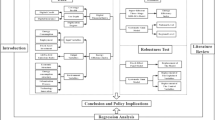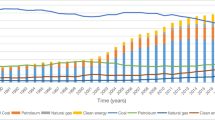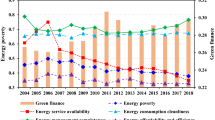Abstract
Financial technology provides strong support for the low-carbon transformation of energy through digital technology. There is limited research on the relationship between financial technology and low-carbon transformation of energy, and the information transmission and connection between the two entities are still unclear. Therefore, this paper innovatively conducts in-depth research on the spatial effect between financial technology and low-carbon transformation of energy and further analyzes the intermediary role of green finance in it. Firstly, the spatial Durbin model and spatial intermediary effect model between financial technology and low-carbon transformation of energy are constructed. Then, based on the Moran coefficient, the spatial effects of low-carbon transformation in financial technology and energy were analyzed. Finally, an empirical study was conducted using the panel data of China’s provinces from 2011 to 2020. The results show that financial technology can effectively promote the energy transformation, and financial technology and the degree of low-carbon transformation of energy have significant spatial effects. From the perspective of intermediary effect, financial technology can effectively improve the green finance structure and promote low-carbon transformation of energy. From the perspective of spatial intermediary effect, while promoting the development of green finance in the local area, financial technology will also suppress the development of green finance in surrounding areas, thereby inhibiting the low-carbon transformation of energy in the surrounding areas. Therefore, China should strengthen the development of financial science and technology, guide the transformation of traditional finance, improve the coverage of green finance, and realize the low-carbon transformation of national energy.





Similar content being viewed by others
Data availability
The data can be provided as requested. For more details, please consult the corresponding author on reasonable request.
References
Baron RM, Kenny DA (1986) The moderator-mediator variable distinction in social psychological research: conceptual, strategic, and statistical considerations. J Pers Soc Psychol 51:1173–1182
Butu HM, Nsafon BEK, Park SW, Huh JS (2021) Leveraging community based organizations and fintech to improve small-scale renewable energy financing in sub-Saharan Africa. Energy Res Soc Sci 73:101949
Chen X, Chen W, Lu K (2023) Does an imbalance in the population gender ratio affect FinTech innovation? Technol Forecast Soc Chang 188:122164
Cheng Y, Zhang Y, Wang J, Jiang J (2023) The impact of the urban digital economy on China’s carbon intensity: spatial spillover and mediating effect. Resour Conserv Recycl 189:106762
Croutzet A, Dabbous A (2021) Do FinTech trigger renewable energy use? Evidence from OECD countries. Renew Energy 179:1608–1617
Ding R, Chen S, Zhang B, Shen S, Zhou T (2022) The reduce of energy consumption intensity: does the development of science and technology finance matter? Evidence from China. Energy Rep 8:11206–11220
Dong F, Wang Y, Su B, Hua Y, Zhang Y (2019) The process of peak CO2 emissions in developed economies: a perspective of industrialization and urbanization. Resour Conserv Recycl 141:61–75
Feng Y, Zhang J, Geng Y, Jin S, Zhu Z, Liang Z (2023) Explaining and modeling the reduction effect of low-carbon energy transition on energy intensity: empirical evidence from global data. Energy 281:128276
Grennan J, Michaely R (2021) Fintechs and the market for financial analysis. J Financ Quant Anal 56:1877–1907
Gu X, Qin L, Zhang M (2023) The impact of green finance on the transformation of energy consumption structure: evidence based on China. Front Earth Sci 10
He L, Liu R, Zhong Z, Wang D, Xia Y (2019) Can green financial development promote renewable energy investment efficiency? A consideration of bank credit. Renew Energy 143:974–984
He H, Luo Z, Wang Q, Chen M, He H, Gao L, Zhang H (2020) Joint operation mechanism of distributed photovoltaic power generation market and carbon market based on cross-chain trading technology. IEEE Access 8:66116–66130
Lee C-C, Wang F (2022) How does digital inclusive finance affect carbon intensity? Econ Anal Policy 75:174–190
Lee C-C, Li X, Yu C-H, Zhao J (2021) Does fintech innovation improve bank efficiency? Evidence from China’s banking industry. Int Rev Econ Financ 74:468–483
Li W, Fan Y (2023) Influence of green finance on carbon emission intensity: empirical evidence from China based on spatial metrology. Environ Sci Pollut Res 30:20310–20326
Li C, Umair M (2023) Does green finance development goals affects renewable energy in China. Renew Energy 203:898–905
Li C, He S, Tian Y, Sun S, Ning L (2022) Does the bank’s FinTech innovation reduce its risk-taking? Evidence from China’s banking industry. J Innov Knowl 7:100219
Liu H, Song Y (2020) Financial development and carbon emissions in China since the recent world financial crisis: evidence from a spatial-temporal analysis and a spatial Durbin model. Sci Total Environ 715:136771
Liu Q, Tang L (2022) Research on the accelerating effect of green finance on the transformation of energy consumption in China. Res Int Bus Financ 63:101771
Liu R, Wang D, Zhang L, Zhang L (2019) Can green financial development promote regional ecological efficiency? A case study of China. Nat Hazards 95:325–341
Liu W, Sun Y, Yüksel S, Dinçer H (2021) Consensus-based multidimensional due diligence of fintech-enhanced green energy investment projects. Financ Innov 7:72
Liu H, Yao P, Latif S, Aslam S, Iqbal N (2022) Impact of green financing, FinTech, and financial inclusion on energy efficiency. Environ Sci Pollut Res 29:18955–18966
Liu H, Nikbakht E, Zhou T (2023) Does product market competition affect the adoption of FinTech by non-financial firms? Finance Res Lett 103730
Ma Y, Zhao Y, Jia R, Wang W, Zhang B (2022) Impact of financial development on the energy intensity of developing countries. Heliyon 8
Pan X, Yan Y, Peng X, Liu Q (2016) Analysis of the threshold effect of financial development on China’s carbon intensity. Sustainability
Pazienza P (2019) The impact of FDI in the OECD manufacturing sector on CO2 emission: evidence and policy issues. Environ Impact Assess Rev 77:60–68
Peng J, Zheng Y (2021) Does environmental policy promote energy efficiency? Evidence from China in the context of developing green finance, Front Environ Sci, p 9
Qiu H, Huang YP, Ji Y (2018) The impact of Fintech on traditional banking behavior—based on the perspective of internet financial management. Financ Res 11:17–29
Ren X, Shao Q, Zhong R (2020) Nexus between green finance, non-fossil energy use, and carbon intensity: empirical evidence from China based on a vector error correction model. J Clean Prod 277:122844
Ren XY, Yang SL (2013) An empirical research on the relationship between foreign direct investment and carbon dioxide emission intensity of China. Adv Mater Res. Trans Tech Publ, pp. 951–957
Renduchintala T, Alfauri H, Yang Z, Pietro RD, Jain R (2022) A survey of blockchain applications in the FinTech sector. Technol Mark Complexity, J Open Innov
Shi X, Li X (2018) Research on three-stage dynamic relationship between carbon emission and urbanization rate in different city groups. Ecol Ind 91:195–202
Shi H, Chai J, Lu Q, Zheng J, Wang S (2022) The impact of China’s low-carbon transition on economy, society and energy in 2030 based on CO2 emissions drivers. Energy 239:122336
Teng M, Shen M (2023) Fintech and energy efficiency: evidence from OECD countries. Resour Policy 82:103550
Walter I, Ugelow JL (1979) Environmental policies in developing countries. Ambio 8:102–109
Wang B (2023) Low-carbon transformation planning of China’s power energy system under the goal of carbon neutrality. Environ Sci Pollut Res 30:44367–44377
Wang S, Liu X (2017) China’s city-level energy-related CO2 emissions: spatiotemporal patterns and driving forces. Appl Energy 200:204–214
Wang Z, Wang X (2022) Research on the impact of green finance on energy efficiency in different regions of China based on the DEA-Tobit model. Resour Policy 77:102695
Wang R, Liu J, Luo H (2021) Fintech development and bank risk taking in China. Eur J Finance 27:397–418
Xie H, Ouyang Z, Choi Y (2020) Characteristics and influencing factors of green finance development in the Yangtze River Delta of China: analysis based on the spatial Durbin model. Sustainability
Xue X, Wang Z (2021) Impact of finance pressure on energy intensity: evidence from China’s manufacturing sectors. Energy 226:120220
Yang Y, Su X, Yao S (2021) Nexus between green finance, fintech, and high-quality economic development: empirical evidence from China. Resour Policy 74:102445
Yang G, Ding Z, Wu M, Gao M, Yue Z, Wang H (2023) Can digital finance reduce carbon emission intensity? A perspective based on factor allocation distortions: evidence from Chinese cities. Environ Sci Pollut Res 30:38832–38852
Yu B, Li X, Qiao Y, Shi L (2015) Low-carbon transition of iron and steel industry in China: carbon intensity, economic growth and policy intervention. J Environ Sci 28:137–147
Yu M, Tsai F-S, Jin H, Zhang H (2022) Digital finance and renewable energy consumption: evidence from China. Financ Innov 8:58
Zarsky L (1999) Havens, halos and spaghetti: untangling the evidence about foreign direct investment and the environment. Foreign Direct Invest Environ 13:47–74
Zhang MM, Wang Q, Zhou D, Ding H (2019) Evaluating uncertain investment decisions in low-carbon transition toward renewable energy. Appl Energy 240:1049–1060
Zhang H, Duan Y, Yang J, Han Z, Wang H (2023a) Can green finance improve China’s haze pollution reduction? The role of energy efficiency. Environ Dev 45:100833
Zhang Q, Que J, Qin X (2023b) Regional financial technology and shadow banking activities of non-financial firms: evidence from China. J Asian Econ 86:101606
Acknowledgements
The authors are grateful to the editor and anonymous reviewers for their work.
Funding
This study was supported by the Fundamental Research Funds for the Central Universities (2020MS048) and the general project of Humanities and Social Sciences Research of the Ministry of Education (23YJA790024).
Author information
Authors and Affiliations
Contributions
SG: methodology and conceptualization. KZ: conceptualization, writing—original draft, and preparation. GL: data curation, reviewing, and editing.
Corresponding author
Ethics declarations
Ethics approval and consent to participate
Not applicable.
Consent for publication
Not applicable.
Competing interests
The authors declare no competing interests.
Additional information
Responsible Editor: Eyup Dogan
Publisher's Note
Springer Nature remains neutral with regard to jurisdictional claims in published maps and institutional affiliations.
Rights and permissions
Springer Nature or its licensor (e.g. a society or other partner) holds exclusive rights to this article under a publishing agreement with the author(s) or other rightsholder(s); author self-archiving of the accepted manuscript version of this article is solely governed by the terms of such publishing agreement and applicable law.
About this article
Cite this article
Zhang, K., Guo, S. & Liu, G. The impact of financial technology on China’s low-carbon transformation of energy and mechanism analysis. Environ Sci Pollut Res 31, 5190–5208 (2024). https://doi.org/10.1007/s11356-023-31288-9
Received:
Accepted:
Published:
Issue Date:
DOI: https://doi.org/10.1007/s11356-023-31288-9




